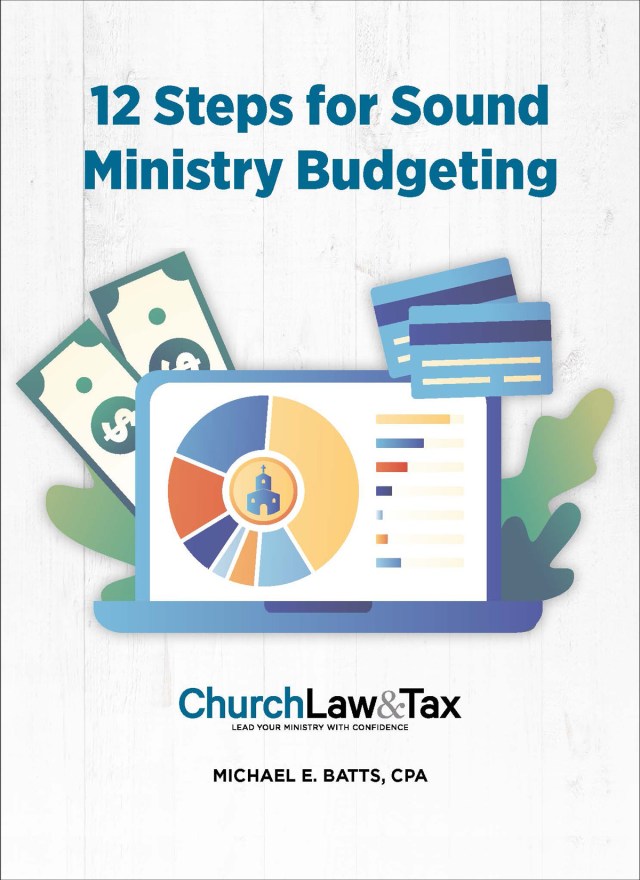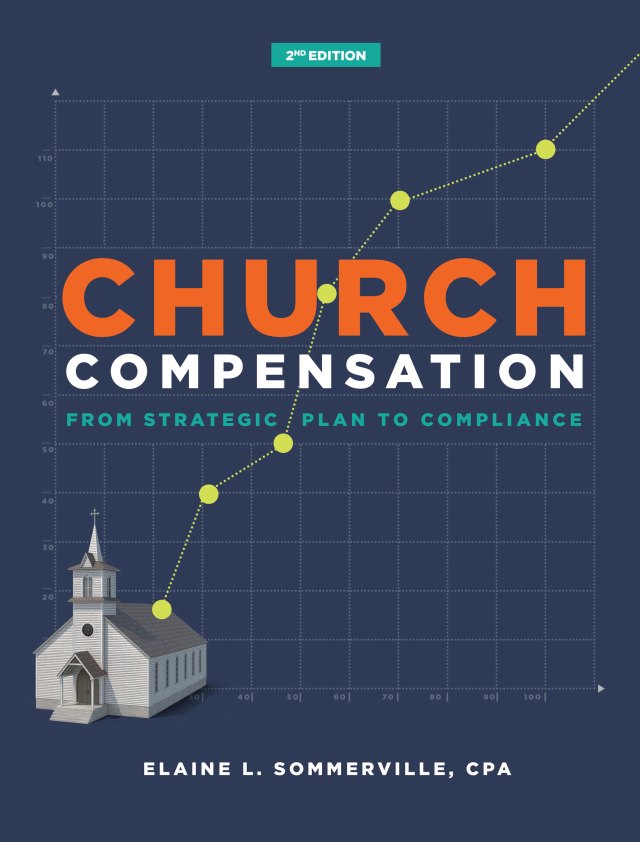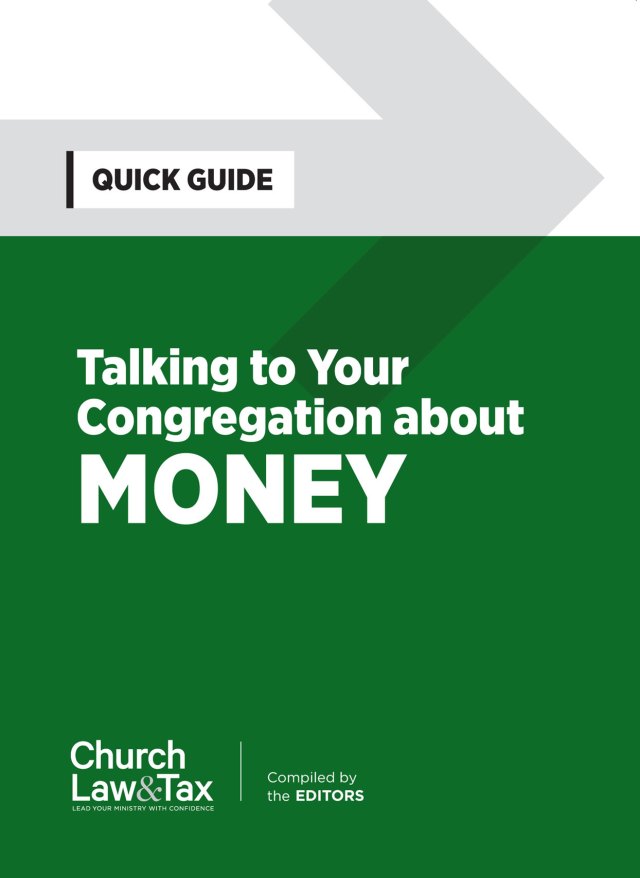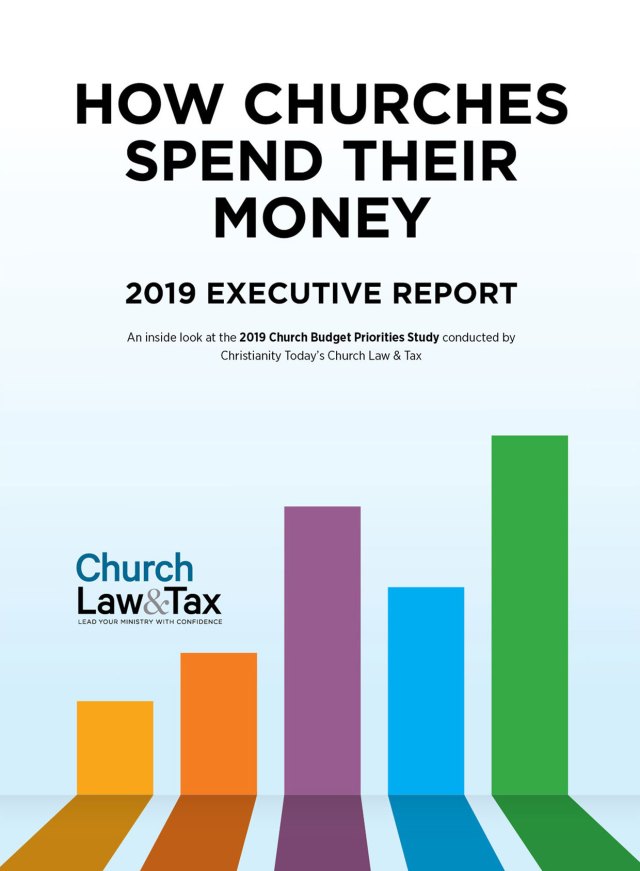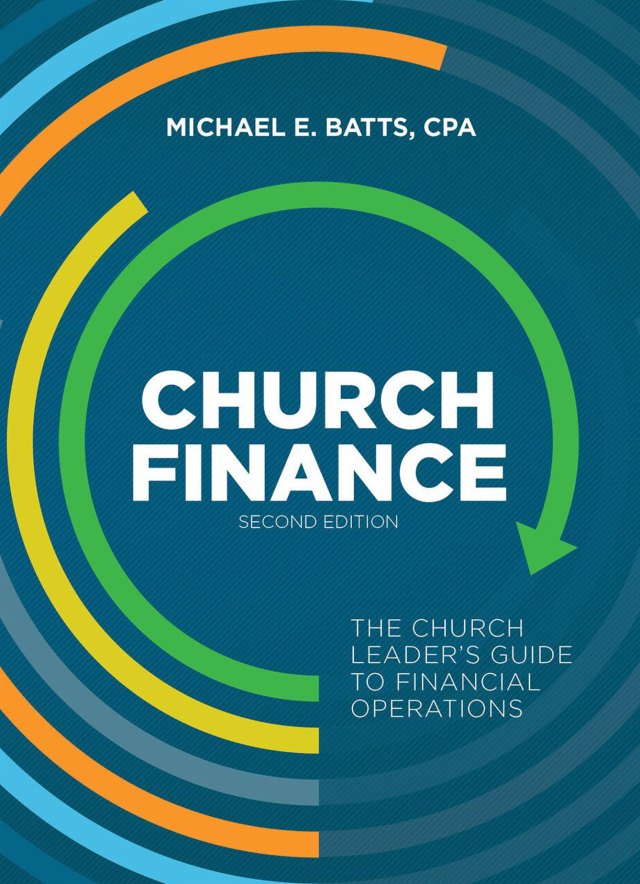In conversations, e-mails, and discussion board posts, church business administrators, treasurers, and executive pastors often ask about the “budget ratios” of other churches. The term may sound technical, but really, it comes down to a simple question: How do other churches spend their money and how does their spending compare to our church?
Such comparisons can help leaders discern whether what they spend on things like salaries, facilities, ministry programs, and missions, are too much, too little, or just right.
With that in mind, Christianity Today’s Church Law & Tax Group commissioned independent market research firm Solver Solutions in April 2014 to conduct the “Church Budget Priorities Study.” Our goal was to learn how churches nationwide spend their money so that when leaders ask about budget ratios, reliable information readily exists.
“Budget ratios are a quick reference to ensure we are not getting ‘heavy’ in one area or another,” says Anne Kessler, business and facility manager at Church of the Resurrection, a Wheaton, Illinois, congregation where about 1,000 people attend each week. “If we are, we pause to address if that ratio variance makes sense for our current vision and for the direction the Lord is calling us to.”
The “Church Budget Priorities Study” invited leaders who subscribe to various publications and e-newsletters published across the Christianity Today ministry to participate. The effort generated nearly 2,200 qualified responses. Questions focused on current budgets.
Among qualified respondents, average weekly attendance was 517 people and average budget size was $879,900. The median weekly attendance was 274 people and the median budget was $614,540. Figures naturally fluctuate base on church size, as these numbers show:
Churches of less than 200 people log an average budget of $219,370 and a median of $173,370;
Churches of 200 to 499 state an average of $675,290 and a median of $628,720;
Churches of 500 to 999 report an average of $1.35 million and a median of $1.28 million; and,
Churches of 1,000 or more record an average of $2.16 million and a median of $2.33 million.
To go deeper, here are five key survey findings for churches of all sizes, backgrounds, and settings, and reactions from men and women leading churches nationwide:
Finding #1: People remain the largest budget expense
Once again, salaries and benefits remain the top expense for churches, regardless of size. On average, 47 percent of a church’s budget pays pastors and staff. In other church budget surveys conducted by the Church Law & Tax Group and its predecessors dating back to 1999, personnel costs have consistently ranked first among all budget expenses.
In one respect, this trend makes sense and underscores the value of people to the local church. The preaching, teaching, and administration necessary for an American church today invariably involves the work of individuals who are specially trained and called. In another respect, though, this trend again will prompt some people to ask healthy questions about the roles of the laity.
“The American church has spent less on staffing in the last decade,” says David Fletcher, executive pastor of EvFree Fullerton, a congregation in California that draws about 5,000 people each week. “But churches tend to devolve back into hiring more staff—that is the first solution to so many problems. The challenge is to give ministry away to the people of the church. The common complaint from staff is that ‘volunteers take so much time to train.’ Knowing the results from other churches helps one acknowledge the challenge and keep staffing dollars in check.”
Churches with less than 200 people in weekly attendance spend an average of 45 percent, according to the latest survey, while churches of 200 to 499 spend 48 percent, churches of 500 to 999 spend 49 percent, and those with 1,000 or more spend 50 percent.
Seacoast Christian Community Church runs 12 campuses throughout South Carolina and North Carolina, but it has consistently spent between 48 percent and 51 percent of its unrestricted giving on personnel costs throughout the years. That’s true even now with 12,000 people attending each week, according to Glenn Wood, the church’s administrator.
“Our senior pastor, Greg Surratt, has told our congregation for years that the church can never afford to hire enough personnel to do ‘the ministry of the church’ and that it is the congregation’s job to step up and help the church walk out its ministry in the community,” Wood says.
A closer look at how salaries and benefits are paid reveals some other interesting details. Full-time pastors receive the largest share of salaries and benefits paid (on average, 28 percent of the total personnel budget). Full-time staff, with an average of 11 percent, is second.
As far as types of pay and benefits, the average breakdown looks like this:
28 percent for base salaries/wages;
9 percent for housing allowances;
5 percent for health insurance;
2 percent for pension/retirement plans;
2 percent for employer-paid Social Security and Medicare;
2 percent for payroll taxes;
1 percent for auto allowance or reimbursement;
1 percent for life and disability insurance; and,
1 percent for continuing education.
These percentages remain consistent, regardless of church size.
Finding #2: Property expenses rank a distant second
Property-related expenses draw a notable portion of church budgets, but not as much as many may assume.
A church’s mortgage, rent, or lease as an individual expense takes up an average of 7 percent of a church’s budget, regardless of church size, tying it for third among all expenditures. When all property-related expenses are combined (meaning mortgage/rent/lease, utilities, maintenance/cleaning/groundskeeping, and property/liability insurance), they eat up, on average, 22 percent of church budgets. That’s sizable, but still a distant second to personnel.
“A building is a great tool for ministry. That’s all it is,” Fletcher says. “I don’t know many carpenters who come to a job site without a full toolbox.”
Church size has little effect on the average percentages for individual property expenses; in addition to a mortgage, rent, or lease, 7 percent goes to utilities, 5 percent to maintenance/cleaning/groundskeeping, and 3 percent to property/liability insurance.
“Our building is available for use by all of the congregants,” says Linda Goodnough, business administrator at St. Philip Lutheran Church in Littleton, Colorado, where about 250 people worship. Roughly a quarter of St. Philip’s budget covers all its facility expenses. “We also have a tremendous number of nonprofits who are allowed to use the building at no cost to them. Is it worth it? Our pastors believe so. They don’t want the building to be empty.”
Finding #3: Among programs, children and youth get the most
Nearly 10 percent of church budgets, on average, funds ministry programs, with children’s and youth ministries receiving 4 percent. Adult ministries receive 2 percent, as do music/worship, followed by benevolence, which receives 1 percent.
It’s important to note that personnel expenses still directly and indirectly fund individual ministries. “Using the children’s ministry as an example, that 4 percent of the budget is just to buy curriculum, art supplies, Cheerios, and so on,” Kessler says. “By itself, it looks pretty bad. However, when you add in the children’s pastor’s salary and the physical space the children use in the building, it is a totally different picture.”
The same is true of support sent to denominations. At St. Philip, 6 percent goes to its denomination, but that, in turn, funds local and national ministries, Goodnough explains.
Likewise, property expenses also fuel individual programs, as Kessler noteswith children’s ministry. At Church of the Resurrection, building expenses increased from 14 percent to 24 percent after the congregation moved into its own facility in December 2012 (“Building on Budget,” Church Finance Today, May 2013).
“I can say with high confidence that this additional cost has had invaluable results. Our children have a safe environment they can call their own and the children’s ministry has almost doubled in the last two years,” Kessler says. “We have also seen a level of adult ministry happening that could never have been accomplished as a mobile church.”
Finding #4: Missions receive nearly 10 percent
Among respondents, 81 percent say they provide funding support to domestic missions and spend an average of 4 percent of their church budgets to do so. Regarding international missions, 75 percent say they provide funding support and spend an average of 5 percent of their budgets on that front.
The average percentages hold relatively consistent among church size.
“We don’t spend as much on international missions, although we do spend some,” Goodnough says. “We opened a food bank in June, so now we will see an increase in that amount domestically.”
Finding #5: Giving decreases have affected budgets—but only for some
When we asked churches whether they considered six or more types of cost savings measures during the past year, 49 percent say yes, but only 39 percent actually took any such action.
Of those who took cost savings measures, salary freezes (21 percent) and program cuts (20 percent) are the most common tactics. Hiring freezes come in a distant third (8 percent), followed closely by pay cuts (7 percent). There are no significant statistical differences observed by church size.
Those who cut costs did so because of declines in giving. While 70 percent of churches say giving was flat or grew, the remaining 30 percent say giving declined by 2 percent or more.
Giving has decreased at St. Philip in 2014. Goodnough says the church took several approaches with cost savings measures throughout the past three years, including replacing outdated light bulbs and windows with energy-efficient ones and switching to electronic bulletins and newsletters. Special fundraisers also were used to help fund specific church needs, she adds.
In the survey, 22 percent of churches say the current year’s budget decreased compared to the prior year’s, while 48 percent say the current year’s budget increased compared to the prior year. Another 28 percent say their budgets were the same year-over-year.
Looking ahead, 14 percent of respondents project giving declines of 2 percent or more, and of that group, 28 percent expect to cut spending 2 percent to less than 5 percent, another 13 percent expect to cut spending 5 percent to less than 10 percent, and 6 percent anticipate decreasing spending by 10 percent or more.
“As attendance has risen, average giving has also remained fairly steady but has declined slightly in some campuses,” says Seacoast’s Wood, adding that the church plans to relocate one campus and open another one this fall. “This has also provided additional opportunities for more volunteers to step up and become more involved in ministry than ever before. … We are encouraged with the growth opportunities that are ahead and are excited about the ministry possibilities they provide for not only Seacoast, but for all churches.”
Finding the right ratio
As Kessler points out, each church’s budget must be uniquely defined by the values and vision it believes the Lord has given it. No universal “budget ratio” exists for churches to follow.
And church-to-church comparisons also aren’t perfect. The spending priorities of a large suburban church near Dallas likely will look much different from a small rural one in Kansas. Likewise, two 300-person congregations in Ohio still may face very different circumstances—and thus very different budget allocations—simply due to their ages, member demographics, and denominational affiliations (or lack thereof).
Churches also may place similar types of expenses under different budget categories.
“It is hard to get apples-to-apples comparisons. For example, some churches include their missions support in their total budget and some exclude it,” says EvFree’s Fletcher.
These caveats aside, the information is still powerful. “I get budget ratios all the time and find them quite helpful,” Fletcher adds.
Helpful especially now as most churches enter their budgeting seasons (the survey revealed 71 percent use calendar-year budgets that begin on January 1, and 71 percent begin their budgeting seasons two to less than six months ahead).
“These ratios are good to ensure that we are operating in similar fashion to other churches,” Wood says. “This type of information helps us all to work with acceptable boundaries in our ministries.”

